Mugolio, a dark, aromatic syrup imbued with the flavor of pine cones, is the poster child for the kind of crazy cool, Illuminati-esque foodstuff foragers have access to, all for the price of a hike, or even less, depending on how close you are to some pine trees.
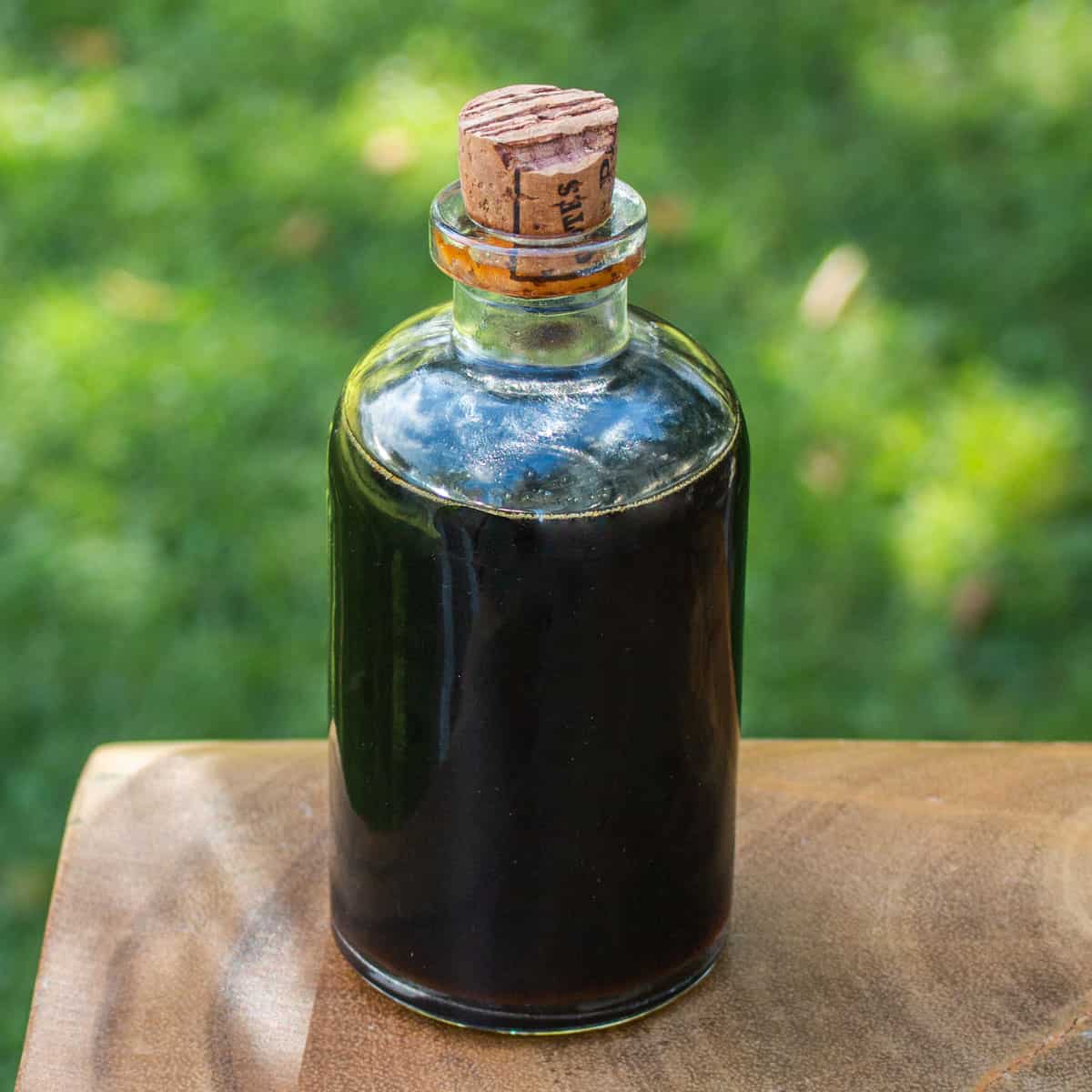
The syrup came on my radar when my friend Dan Farmer gave me a little jar of some he made to try. I remember it being good, but I forgot about it until I opened the Salt Cellar, and started making my own from spruce tips, which is excellent, but not quite the same as pine cone syrup (for the record both are great).
Mugolio is now still a bit of a chef secret, and available through elite specialty distributors, but the price is staggeringly high, exorbitant even, when you consider you can make nearly the exact same thing at home, for less than it costs to make a cake.
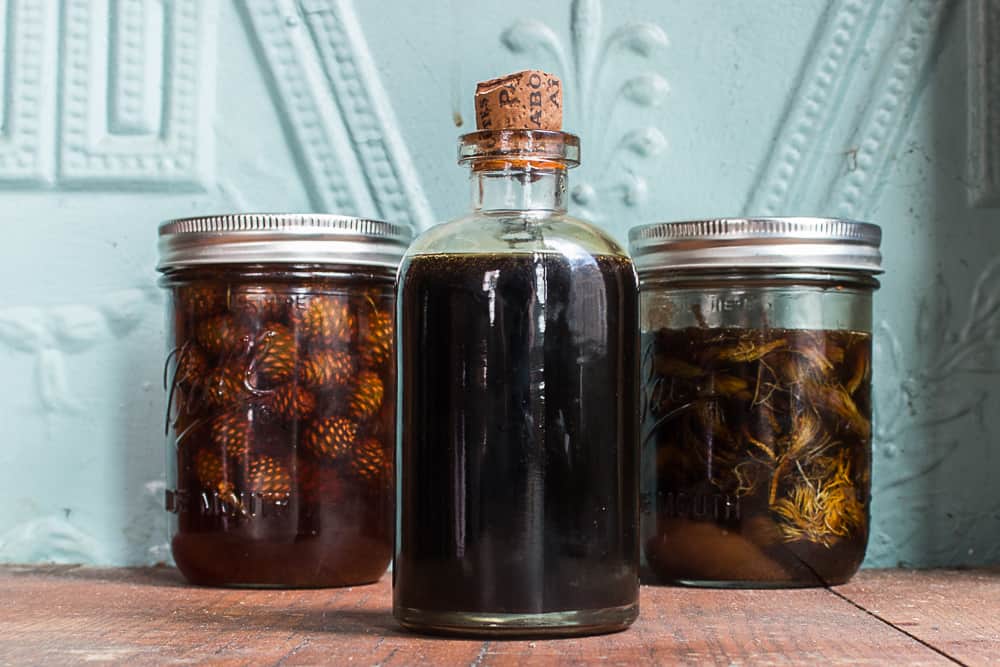
A chef secret that takes months to make
The cost of mugolio is not found in ingredients, but is paid in time. How much time is certainly up for debate, and you’ll notice my recipe turns around a lot quicker than burying a jar of pine cones and sugar in the yard and digging it up the next year (an actual recipe from Romania). You’ll want to wait at least a month for a good pine syrup, although aging it longer can be fun.
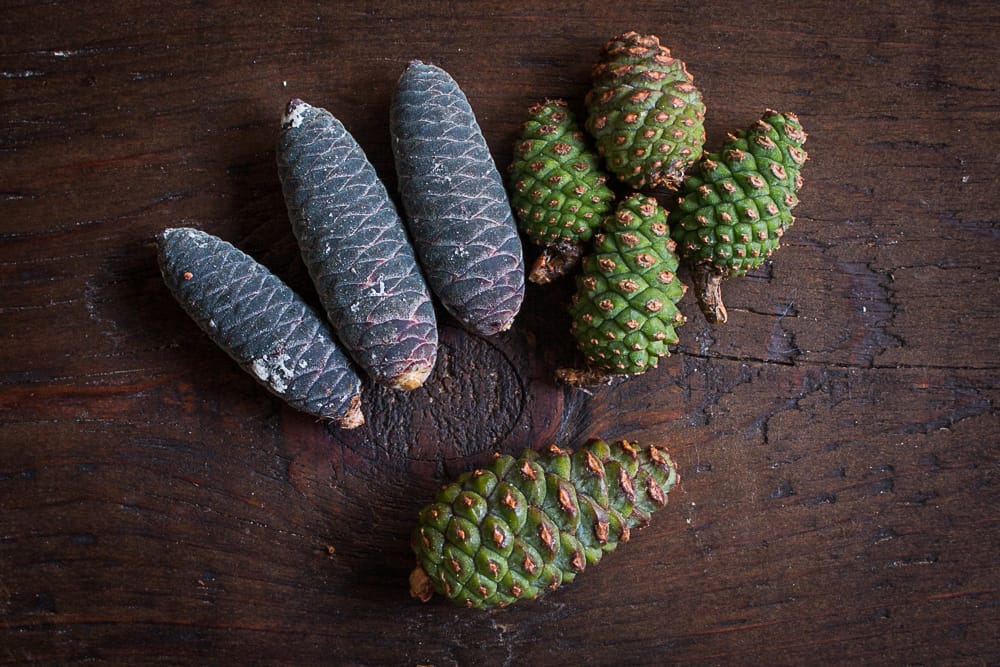
Mugolio: more than just pine cones
Real quick, some reality. I use the word mugolio interchangeably for syrups made from numerous tree parts, if you look around you’ll see mugolio usually refers to a syrup made from the young cones of mugo pine (Pinus mugo), harvested at a specific time of year, under the strictest of conditions, blah, blah, blah.
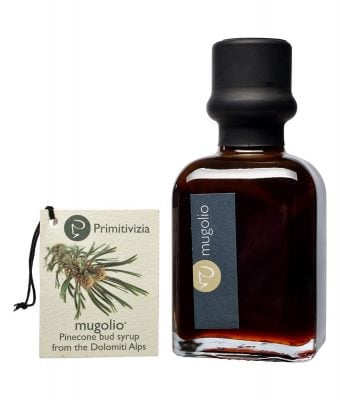
I’ve made all kinds of similar sugar based products from all kinds of conifer parts, and it isn’t some difficult, arcane thing you can only do in the light of a full moon— just the opposite.
Making mugolio is easy, and there’s a very forgiving time window for harvesting cones, or other things products like cedar cones, wintergreen, juniper, or spruce tips. All of the aforementioned making excellent syrups in their own right.
There’s something special about the pine cone syrup though. Pine cones hold more water than any other thing I’ve used, and they also ferment during the maceration process, vigorously.
The day after you combine the pine cones and sugar, there will look as if there was a rush and release of water—what was once a solid packed jar of pine cones and sugar is not 75 % full and liquid.
Species of unripe pine cones I've used to make syrup
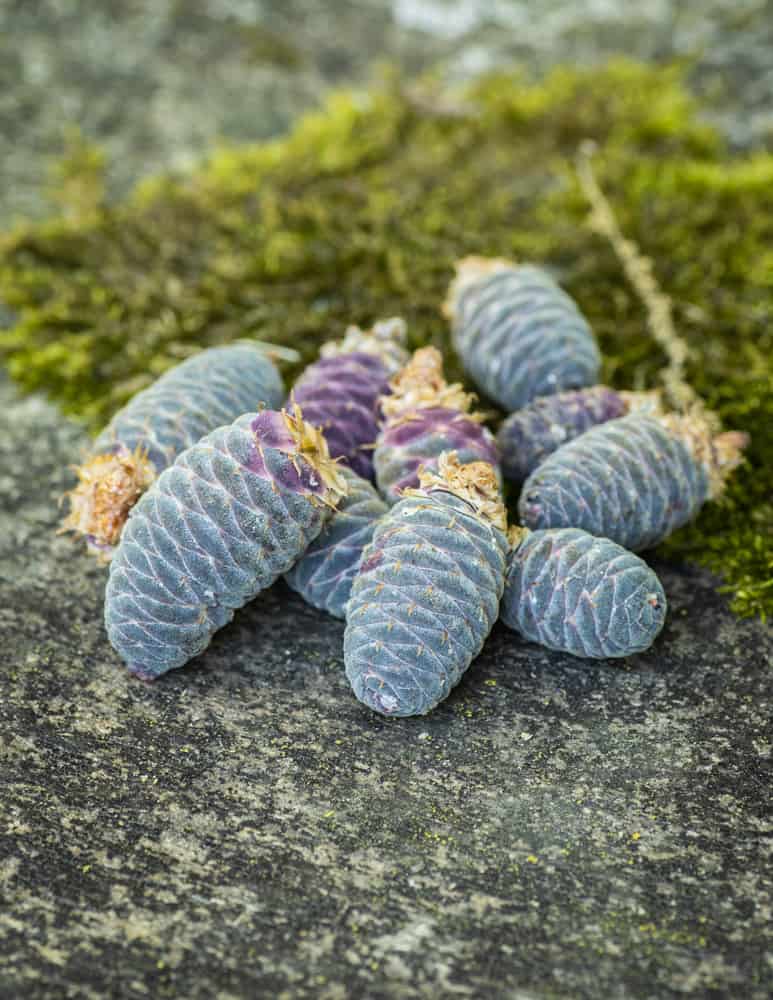
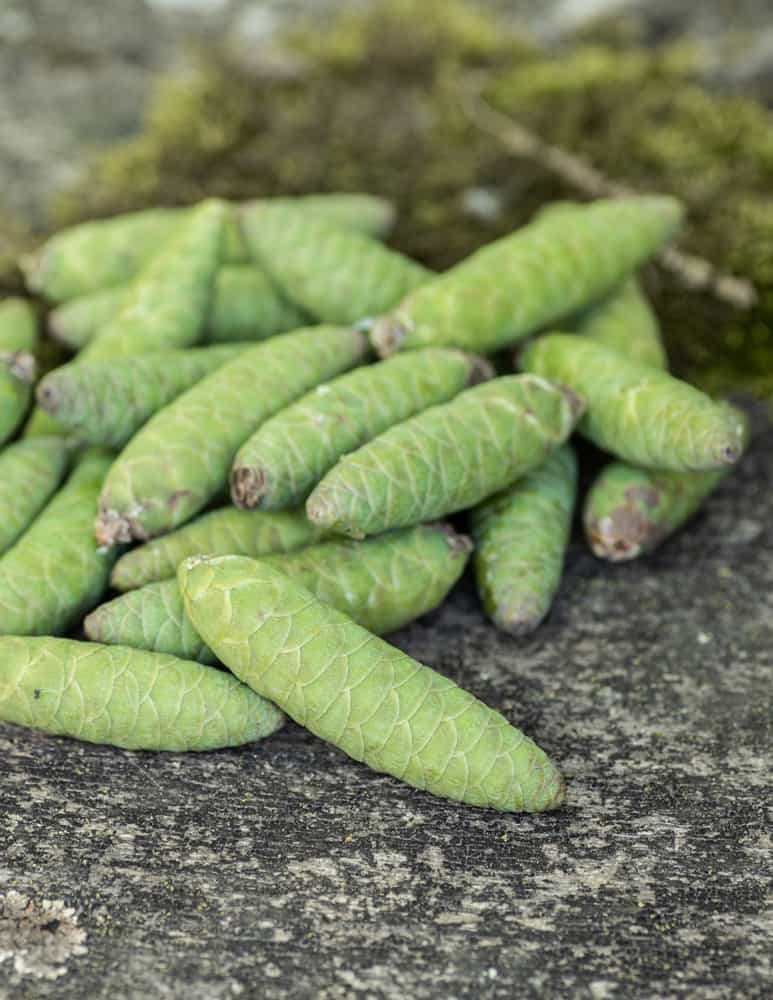
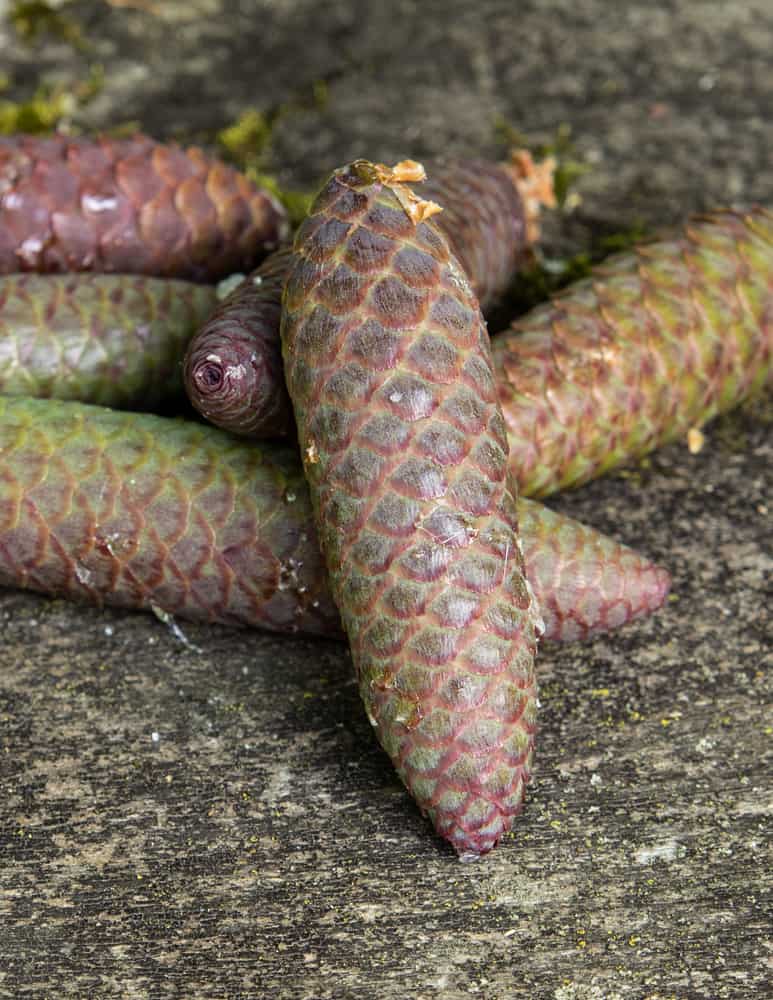
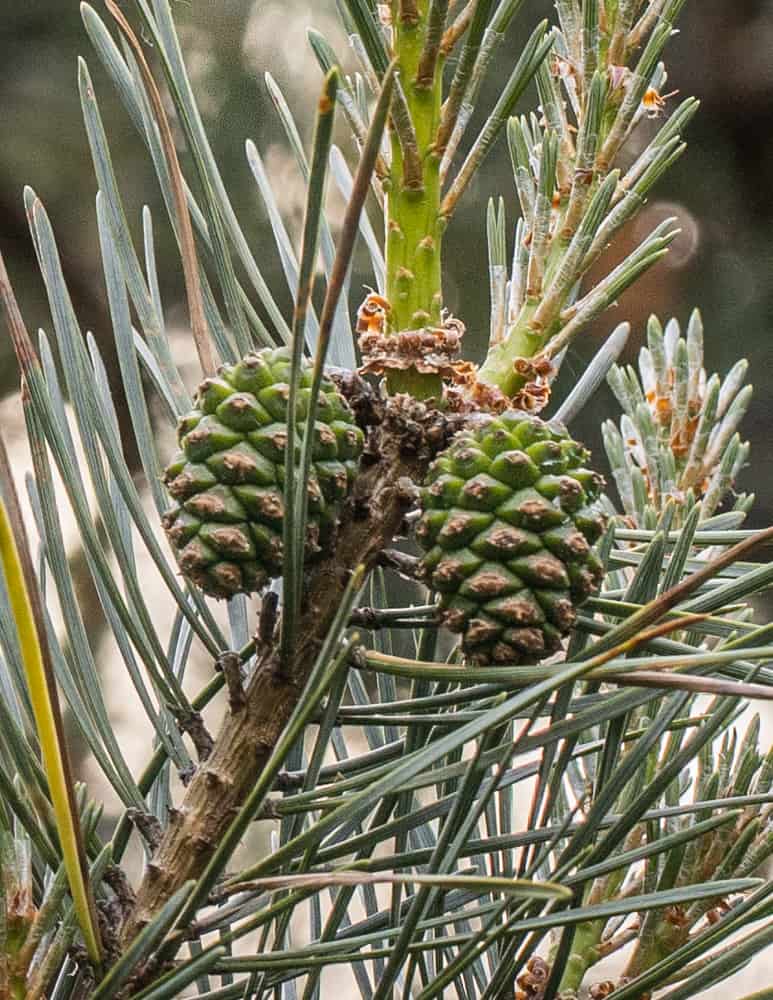
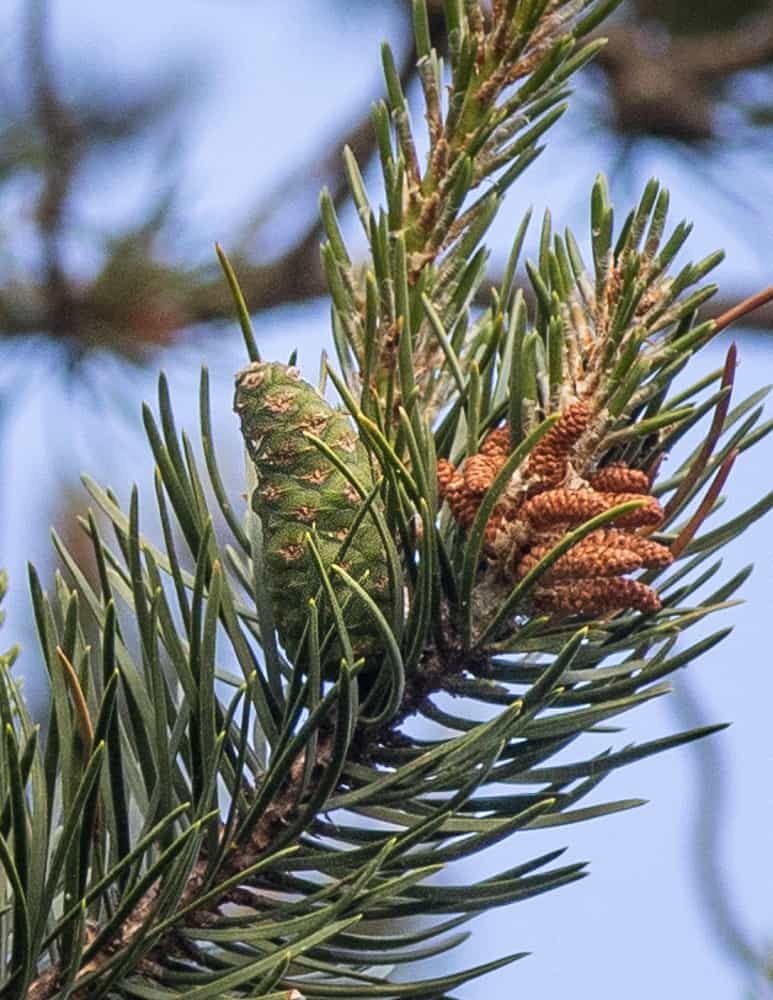
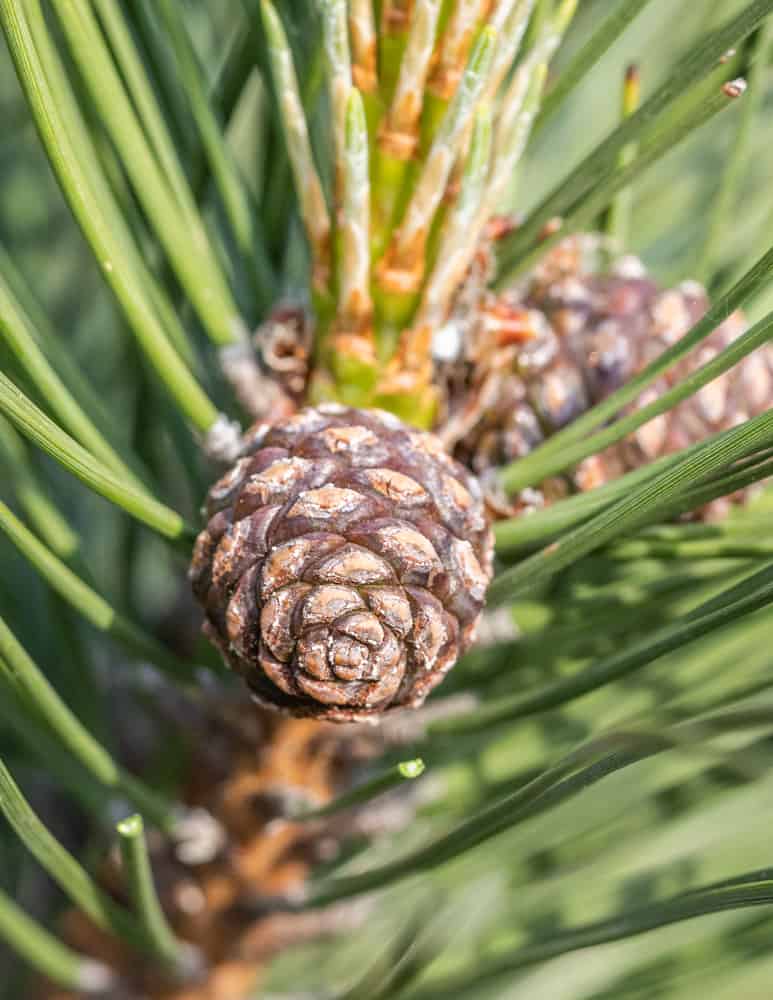
Variation in flavor between species
One of the most fascinating things about mugolio is that every species of tree you harvest unripe cones from will impart a noticeably different flavor unique to the finished product.
Once I started to notice the different flavors, I made a point out of trying to "mugolio" as many different species of unripe coniferous cone I can, and I found some fascinating things. Here's a quick breakdown of the differences between flavors I taste.
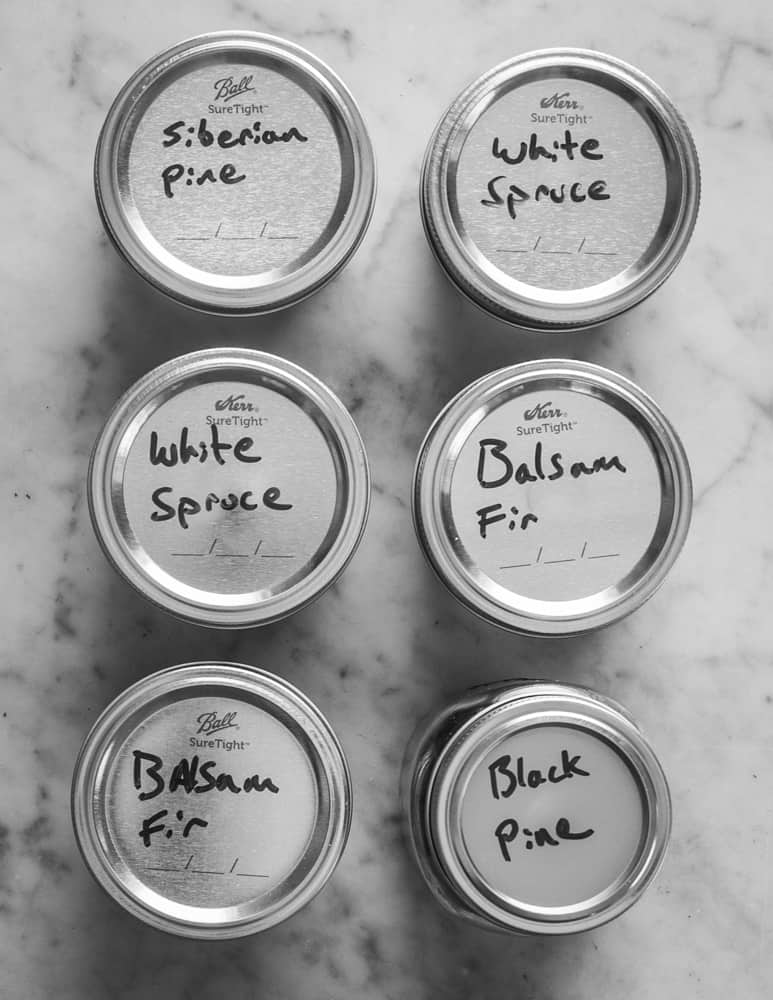
Pinus/Pines
Mugolio made from pinus cones have a resinous, assertive taste.
Picea/Spruces
Spruces lack the aggressive resinous flavor of pines and are the most subtle of all I've tasted. Instead of the resinous taste, spruce cones, just like spruce tips, have a citrusy note to them, and so will syrups made from their cones.
Thuja and likely others/Cedars
The only cedar I've made mugolio with is the green cones Thuja occidentalis, since they're easy to find in landscaping. It has a taste exactly like the aroma of fresh green cedar, a bit in between spruce and pine mugolios.
Abies/Firs
Of all the syrups here, and all the different flavors, the syrups I've made from balsam fir are the most delicious.
Firs have a resinous punch like pine mugolios, but it's slightly less aggressive, and most noticeably, comes with strong notes of warm spices like cloves, allspice, and cinnamon.
Unfortunately, mature balsam fir trees, at least around me, seem to only want to grow cones at the very top of the tree, which can make getting enough for a batch of syrup tricky.
Using other conifer products
Other tree products like spruce tips, pine tips and cedar cones I've worked with are more dry, and may not ferment during the maceration process, but they can still make a fine syrup.
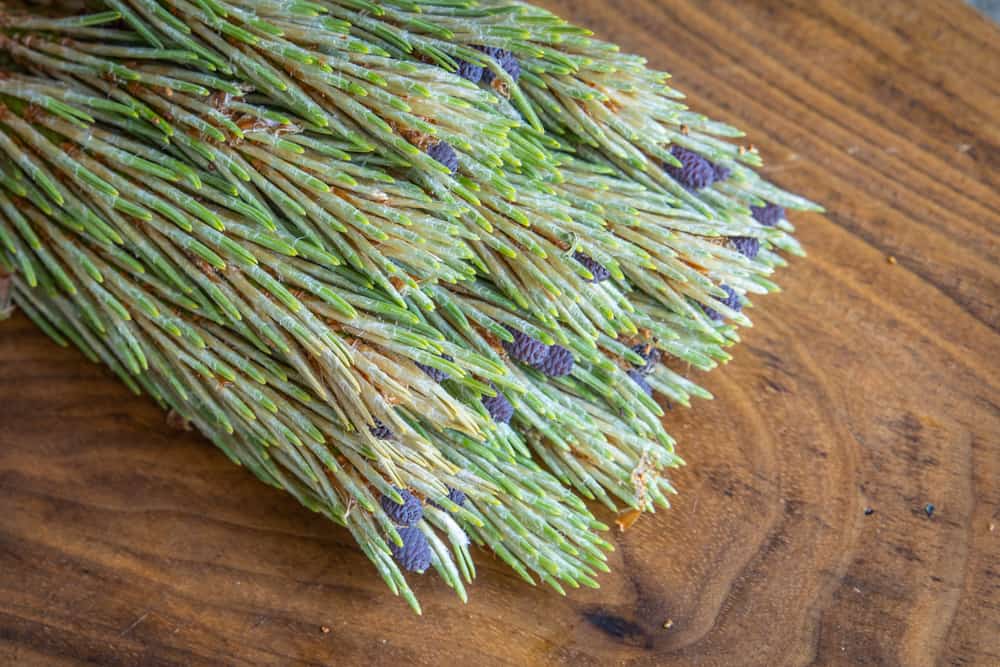
The point is: you can make syrups like this out of all kinds of things, and everyone I’ve had has been good. If you have spruce trees near you, take a look at the basic spruce tip syrup too, which is nearly the same, sans the fermentation. Here's a few things I've used:
- Unripe eastern white cedar cones (Thuja occidentalis. This could can be an abortifacient in high doses)
- Juniper berries (Juniperis virginiana)
- Spruce tips (many species)

The best part is figuring out how to use it. Somethings take some experimentation, mugolio not so much.
You can literally put it on just about anything where maple syrup would be good, and you’ll be glad you did. The syrup has the essence of pine, but with none of the strong tannins you’d expect If you took a bite out of a pine cone—just pure piney goodness.
Harvest young pine cones in spring or early summer
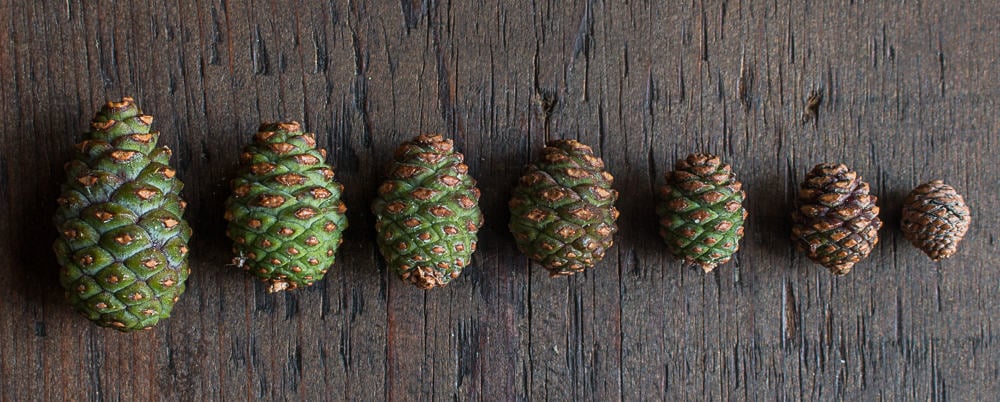
Most importantly, you are looking for unripe pine cones in the spring and early summer, not the fall, not the winter. Opened cones are not to be used.
This is up for debate, but my favorite comes from green cones as they contain more water. Purists might say that you need to harvest pine cones when they're the size of a pinky nail, or some other arbitrary size.
I can tell you after making this for years now, that any of the pine cones pictured in the image above will make a fine syrup, but smaller cones will make a syrup with a much stronger flavor, strong enough that some people may not like it.
Another good rule of thumb I've found is that whatever cone you're picking will probably be sticky and exuding resinous, sticky liquid at a prime stage for making pine cone syrup.
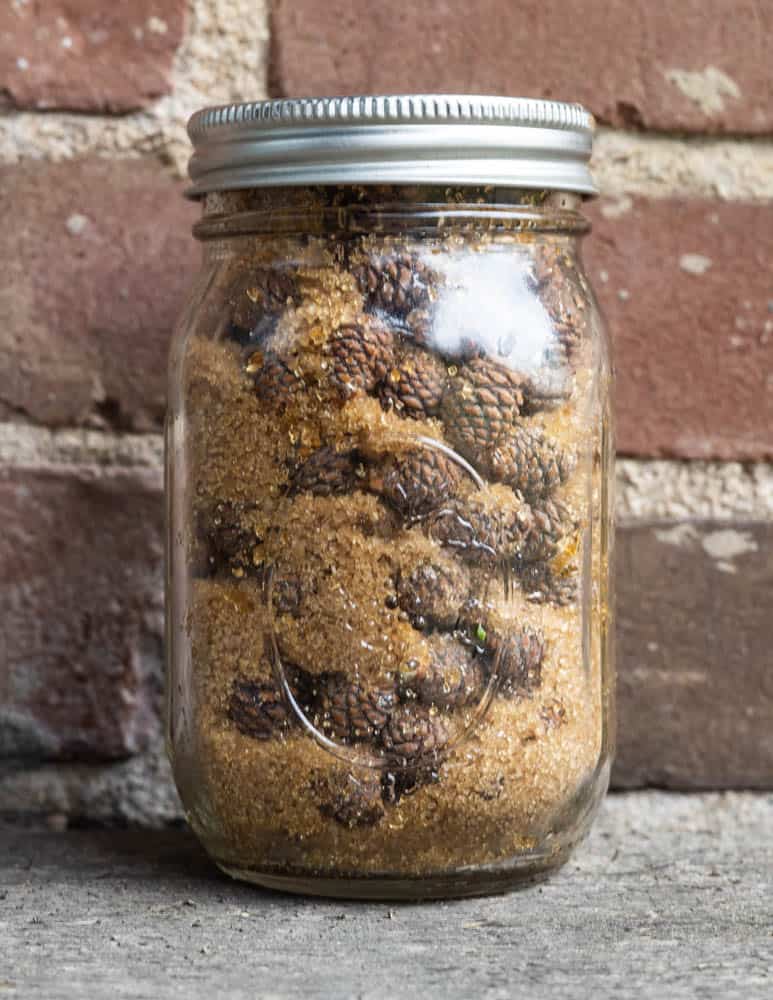
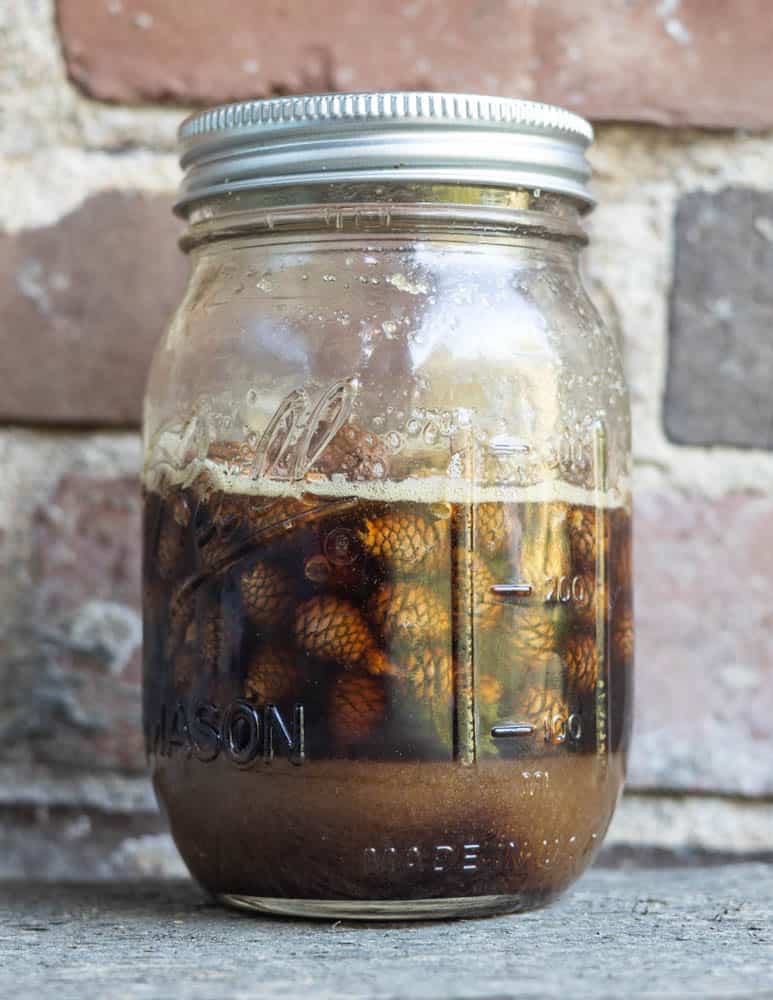
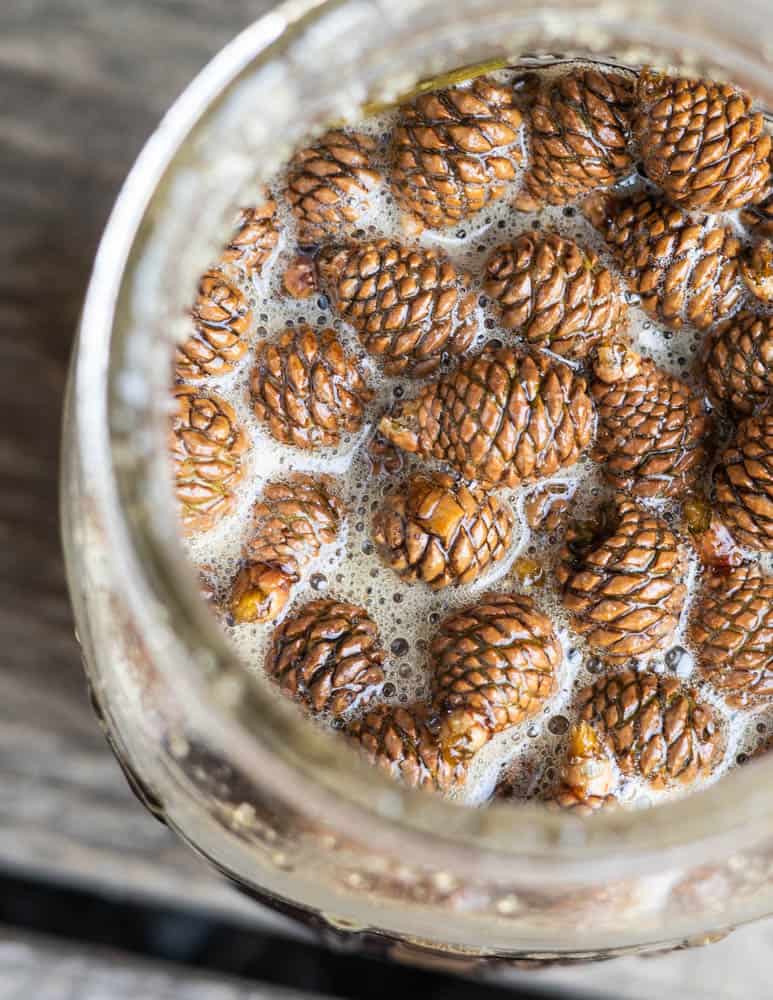
Green cone=higher water content
Larger green cones hold more water in them which makes syrup making much easier, and also allows for some fermentation in the process, which adds fun flavors.
As long as the cones are meristematic and tender, and can be cut through with a knife, even if it's into pieces with long cones like white spruce or balsam fir, they will make a good mugolio. The only cones that won't work, are mature, tough, barky cones, like those you'd see on the ground.
Using very young pine cones
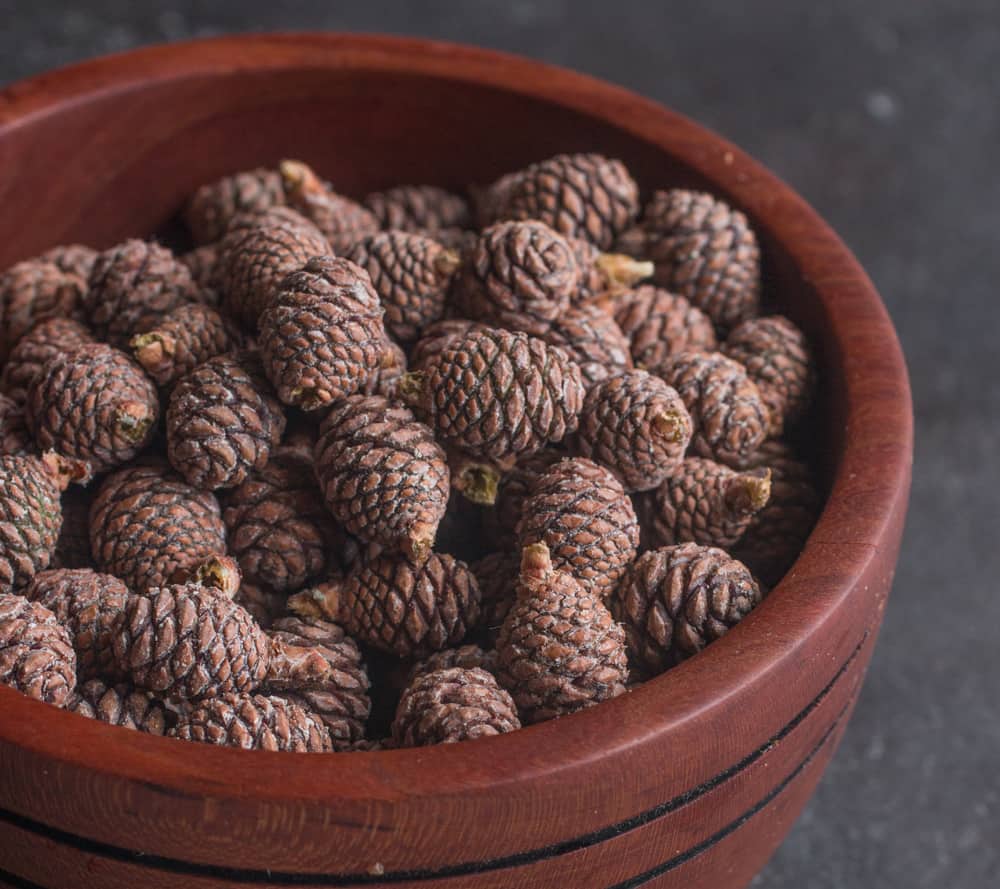
You can use young pine cones, but they're smaller and don't hold as much water as cones that are green, so they're not ideal here.
If you really want to try with very young pine cones, try chopping them up medium to make it so more cones can be fit in a jar, which means more water, meaning an easier syrup. You can also add a splash of water to help it on it's way.
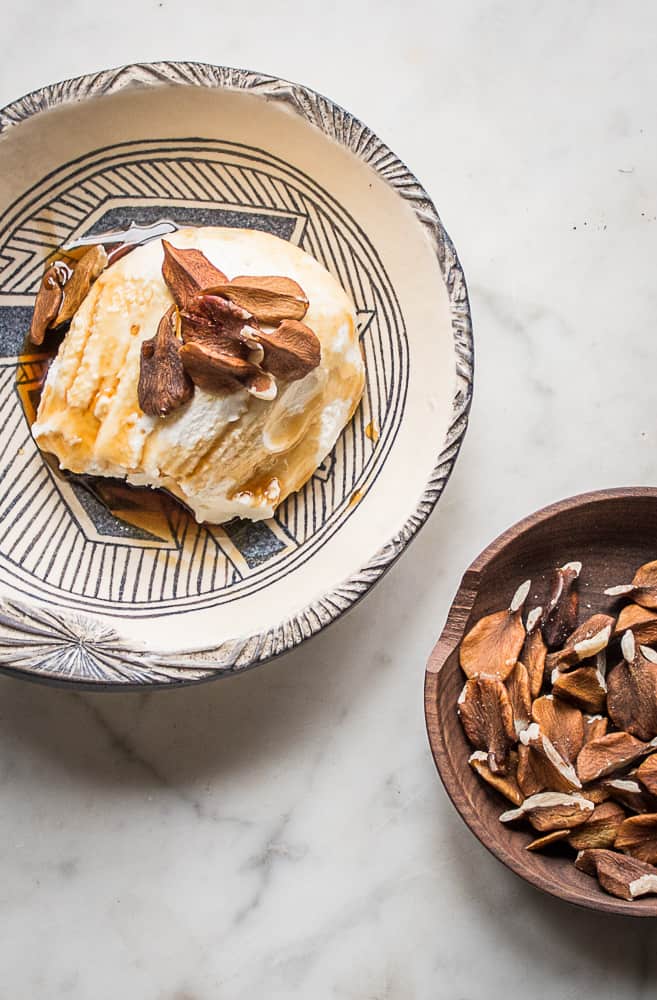
Is it safe?
Yes, this is absolutely, positively safe, and there's no need to worry about botulism. I can't speak to the exact science of spruce tip and cedar cones syrups, (also safe) but pine cone syrup is especially safe as it ferments as it macerates, due to the higher water content of the cones if harvested at the green stage.
The extended fermentation lowers the pH, making it shelf stable. Remember that sugar is a preservative, and conifer products are all naturally acidic, which is a preservative in itself.
Consider using gloves
The most prime pine and spruce cones for making syrup will be plump, but still unripe. At this stage, most of them will be very sticky and oozing a sappy resinous substance that will quickly coat your hands and will stay for hours. Consider wearing gloves to avoid sticky hand syndrome.
Choosing the right sugar
Some recipes might call for white sugar, and while it will work and give you a flavored syrup, white sugar is more dry, and I find the clear color far less attractive than the caramel color that organic, unrefined turbinado-style sugar or even light brown sugar or a similar substitute will give.
I try to avoid using plain white sugar when I can, and I highly doubt that original mugolio recipes used such highly refined products when the first adventurous people crafted them.
Use a good sugar that you can feel good about eating, and drizzling over everything, because you'll want to drizzle it, on, well, everything. Here's a list of sugars that will work
Turbinado
Turbinado is slightly more dry than commercial brown sugars, but it has an excellent flavor.
Light, golden, or dark brown sugar
These are some of the most versatile and affordable, but I suggest using a high quality organic brand. The varying molasses content of the different colors of sugar is negligible in regards to the flavor of the finished syrup.
Maple sugar
Maple sugar is the most expensive you could use, and in my opinion is not the most ideal as it's prone to crystallization from my experience. It is delicious though. If you'd like to harness the flavor of maple with your pine cones, you can just toss pine cones into maple syrup at a ratio of 1 cup of pine cones to 1 lb (2 cups) of maple syrup.
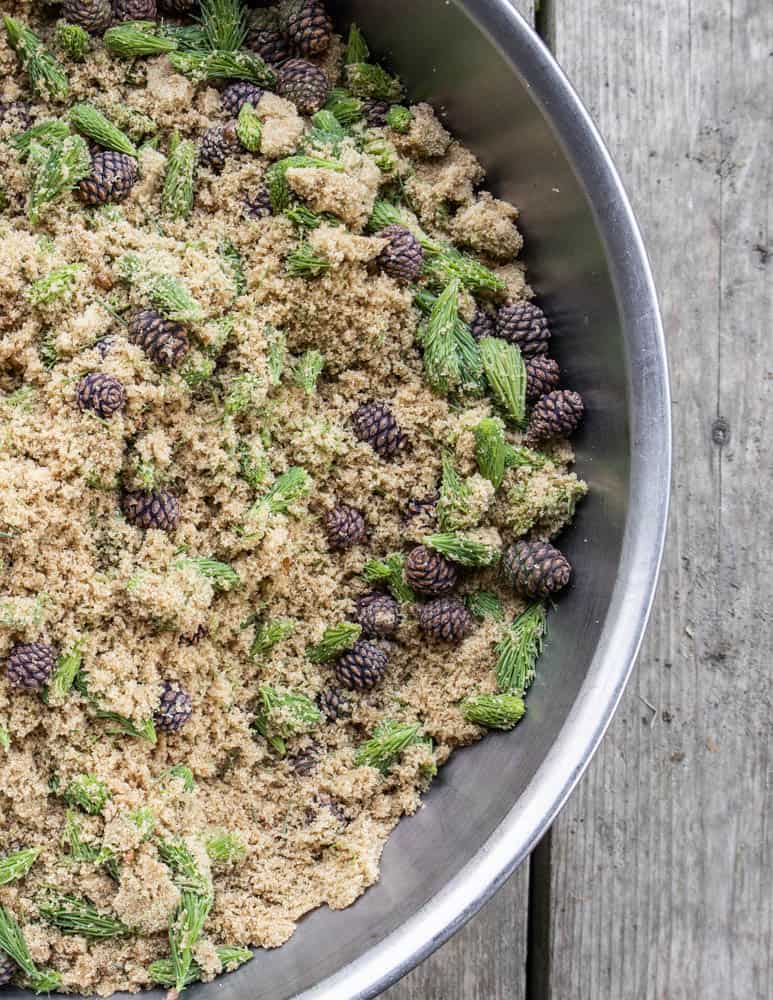
Zirbenshnaps
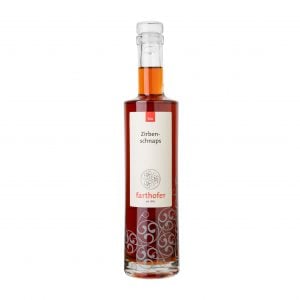
This stuff is unique enough that it needs a special mention. Zirbenschnaps is a liquor made with pine cones.
I’m not an expert on distillation by any means, but I’ve been working with a distillery to make similar products, and one thing we’ve been toying around with is making a rendition of it by simply using it as the sweetener in a macerated liquor.
The traditional zirbenshnaps has a red tone to its color, which makes me think they’re using a syrup made from fresh pine cones cooked immediately—not aged.
I know there’s also birch schnaps, and that’s made with reduced birch syrup, so I think using mugolio would be fine. Currently I know zirbenshnaps is only sold at ultra high-end restaurants in my area.
Whatever you make with it, it’s one of the most fascinating and delicious condiments made from wild ingredients I know of.
Making Large Batches
I occasionally make very large batches of syrup, 2 or 3 gallons at a time. Here's a few tips on doing that if it's something you're interested in, especially as this is such a fun (also cheap) and interesting thing to give as gifts. The tips below are intended for those people making 1 gallon batches and up at a time.
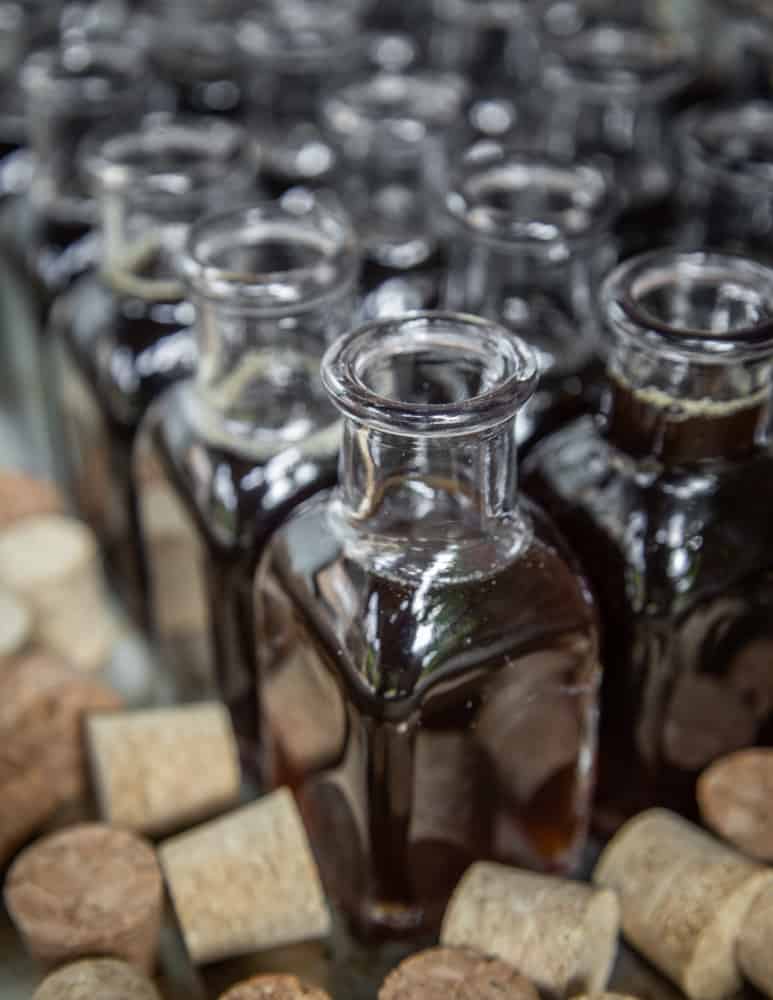
Skimming the foam
Similar to maple syrup, when you cook large quantities of the syrup, it will begin to froth and foam at the top and will double in size quickly.
Some cones seem to create more foam than others, especially Norway Spruce. When you notice foam during the cooking process, do your best to skim it off with a spoon and discard.
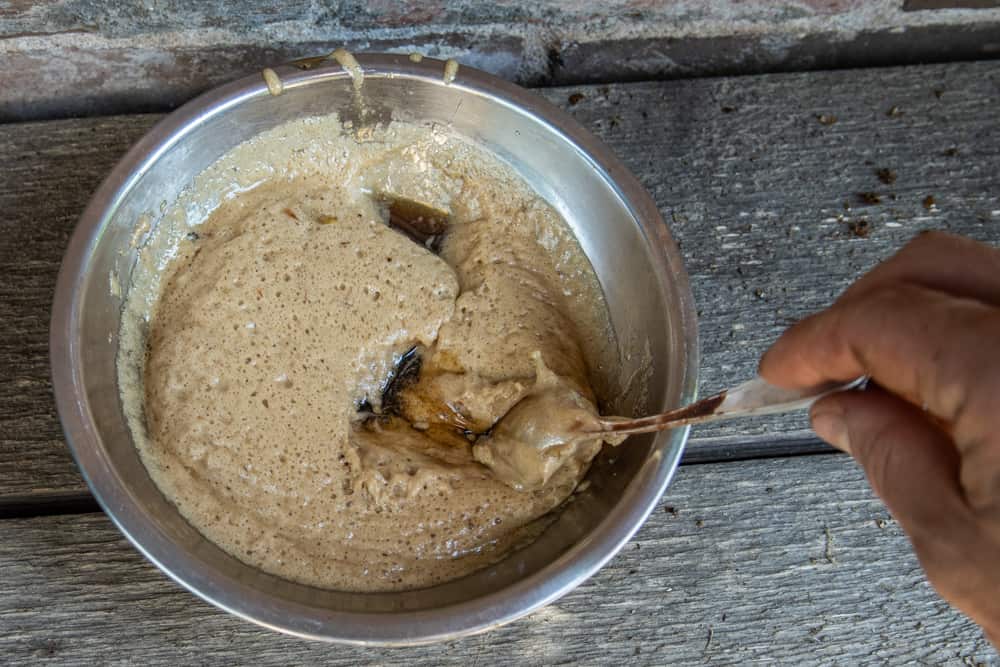
After you bring the syrup to a simmer and strain, put it back in the pot and bring it to a simmer again, let it rest for a minute or two so the syrup can settle and return to it's original volume. If you don't do this, you run the risk of having jars that are half full after settling.
Canning for long-term storage
Pour the piping hot syrup into large jars, or, for smaller ones, pour the syrup into a pitcher with a spout, and pour directly into canning jars (4 oz mason jars make a great gift). Fill the jars nearly to the brim, leaving about ⅛ inch headspace, then, working quickly, screw on the lids tight and turn the jars upside down.
You don't have to water bath-process this as it's basically the same sugar concentration as maple syrup, just make sure your jars are clean. The jars will seal naturally but should be refrigerated after opening.
Here’s a few ideas for using it, and a few things yet on my list to try.
Ideas for using
- Drizzled on pancakes, crepes waffles and other things primed for syrup.
- Use it to flavor whipped cream
- Excellent drizzled over soft cheese like mascarpone, labneh, chevre, etc.
- Drizzled over fresh fruit
- Using in place of honey, I love drizzling it over bowls of warm buttered wild rice with nuts, fruit, and yogurt for breakfast.
- It’s good in desserts, added in small amounts like you would use honey. Dairy based desserts like ice cream, panna cotta and custards of all kinds can just be seasoned to taste with it.
- Try adding small drizzles to salads, or whisking into vinaigrettes.
- Mixing it with a splash of vinegar just to loosen it a bit makes a good brush on or glaze for hams, etc.
- One of my friends adds it to whiskey
Mugolio, or Pine Cone Syrup
Equipment
- 1 quart mason jar or similar
Ingredients
- 2 cups (8 oz) young red pine or other pine cones (soft enough to be cut with a knife) *
- 2 cups (16 oz) organic brown sugar or other brown sugar, just not white which is dry and makes a clear syrup
Instructions
Maceration
- Rinse the cones in warm water to remove any foreign particles if needed. I don't usually wash them. Inspect your cones for any that have holes or insects and discard.
- Combine the sugar and pine cones and pack into a quart jar, then allow to macerate (age) for 30 days. Put the jars in a sunny place where they will get warm during the day, which will help ward off mold.
- During the first few weeks of maceration, open the jar occasionally to release carbon dioxide as the mixture will ferment vigorously. Shake it occasionally to help it on it's journey.
- As the cones release their water, the volume of the contents in the jar will decrease. Sugar slush will settle on the bottom and is natural. If you have more cones and sugar, you can add it to fill up the jar. The less air in the jar, the lower the chance of mold.
Finishing and storing
- After the maceration is complete, scrape the sugar slush and pine cones into a pot and add two tablespoons of water for each quart jar. Bring to a brisk simmer and heat through to melt the sugar, then strain and bottle. Discard the cooked cones and thank them for their service.
- All you need to do is bring the temperature up and melt the sugar, if you reduce the syrup too much it will crystalize after it cools. For the amounts listed it should take about 5-10 minutes.
- The syrup is stable at room temperature since the fermentation lowers the pH, but will keep the best flavor in the fridge. It can also be water bath processed, which I'll do if I sell it. For home storage I pour the very hot syrup into jars, screw on the lids and turn them upside down to seal.

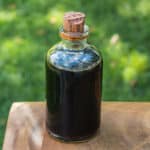
Avanti
Hi Alan,
Does the taste get finer/more complex if I decide to age it for over two months? Or should I stop at 2?
Alan Bergo
Avanti, totally fine to stop at two months. 30 days is the minimum I recommend.
Avanti
Have you ever tried a batch that you took over 2 though?
D
How can I 100% avoid crystallization?
Alan Bergo
Don't overcook it. Heat it up enough until it comes to a simmer which will melt the sugar, then strain.
Ray Katayama
Thank you for your knowledge!
I tried making pine cone jam, syrup and medicinal liquor for the first time yesterday.
However, the pinecone i used is "Deodar cedar".
I didn't see the recipe on the internet made of such kind, so I felt anxiety about toxicity. While researching, I arrived at this site.
Excuse me for the sudden comment. I would appreciate it if you could let me know.
Alan Bergo
All true conifers are edible. Yew (Taxus baccata) is not, and looks quite different.
Ray Katayama
I really appreciate your kindness!!
I will continue to enjoy conifer.
Really you and the blog helped me.
Thank you!!
And I wish your happiness from my heart!!
Alan Bergo
Thanks Ray
Carrie
Very exciting! When making a lot, have you done it in a crock, Ie: with a lid, but not screwed shut? Would that work, or may invite guests.. ( ants)
Alan Bergo
Using a crock could potentially work if you keep it inside and figure out a way to seal it. But yes, I've done large batches and lazily left them outside, only to return and find them crawling with ants. For fun, I brought the mixture to a boil, strained out everything, and it was fine, but it's definitely not ideal and I don't recommend it. Food-grade polycarbonate cambros work very well, as in the types that restaurants use. I recently made 3 gallons in one and left it outside, as the lids are air-tight it kept all the pests out.
Charlotte Jones
Thank you for this recipie. I've made mine with what I think are dwarf mountain pine cones. I feel nervous about mould. Will it be ok to open and stir every now and again? Its in a kilner jar but now its only half full.
Alan Bergo
Charlotte, I have never seen mold on any syrup I've made from any species of pine or spruce cones. This is more of an occasional issue with spruce tips if they aren't agitated regularly. Proceed with no fear.
Charlotte Jones
Thats good to know, I'll do my best to relax about mold.
Andrew Hower
I just discovered a patch of white mold on my batch (it's been going for 5 weeks now). I removed it and gave it a stir. Think it's still ok?
I also started a different batch with Virginia Pine so we'll see how that goes!
Dina
Hi Alan, thanks for sharing your expertise with us! I’ve had a few jars of mugolio resting in my kitchen since this spring, and was sad to find mold growing on the tops of the pine cones (harvested when young from red pine trees) in one of the jars. I assume I should discard that whole jar, right? Do you have any advice for how to avoid this in future batches? I did boil the jar and lid for ten minutes before using it, and agitated/burped it daily during the first few weeks.
Alan Bergo
You don't have to discard the jar, just pick the mold off. It's important to stir the mixture to coat the pine cones with the syrup as it sits, as the mixture ferments, the pH lowers and it will stabalize. You also cook the finished syrup, which is a kill step/sterilization.
joanne
Like Dina, I found mold growing on the air-exposed cones. I cleaned it up manually and ended up putting the jar in the instant pot for a couple house of pressure cooking, with the lid loose, of course. The taste is still fabulous!
Alan Bergo
With the shapes and sizes of cones being highly variable, as well as the ambient temperature of people's homes and where they store ferments, it's possible to see some mold, especially if you don't shake the jar or stir it regularly to coat the cones with the fermenting syrup. Do it a few times and you'll get the hang of it. Practice makes perfect.
David
Hi, thank you for the fantastic, detailed write-up and recipe.
I've seen elsewhere (I believe it was Rene Redzepi of Noma fame) that once macerated and boiled, the pine cones themselves are edible; any advice regarding this?
I have read elsewhere though that they have some detrimental effects, or at the very least are incredibly bitter. I'm baby green pine cones found in UK
Alan Bergo
Hey David. So pine cones harvested for mugolio are larger than the recipe you're thinking of. Varenye is the Caucasian preserve of whole pine cones where the cones are actually eaten, they need to be the size of a pinky nail for that. At the green stage when they're larger they have a higher water content and are perfect for making mugolio. See my method of making pine cone varenye in this link.
Sheila
i see so much on spruce tip syrup...can the young green cones be used as well
Alan Bergo
Sheila, that's exactly what I'm using here. If you're referring to the young green cones of spruce, they can absolutely be used as well.
Sheila
ty so much i have trees full of them and cant wait to try them
Alan Bergo
You'll love it. Have fun.
Raquel Pallak
Hi. Are you using only female cones or will male pollen cones do as well? Thanks
Alan Bergo
Male cones won't work.
Angel
I just found this site, and it’s lovely.
Thank you for writing such a detailed account of this edible.
I just put some green cones from long leaf pine to macerate with jaggery. It will be interesting (or not, since jaggery is just sugar.)
Alan Bergo
Thanks Angel.
sean
Excited to make this with the spruce tips and cones I am gathering. What about trying this with juniper (eastern red cedar in MN) berries later in the summer? I imagine it would create a gin-like taste. Could cedar branch tips be used as well?
Alan Bergo
Sean, you can probably make it with eastern red cedar, but I would try Thuja occidentalis cones first (Eastern white cedar). When improvising, remember that the water content of the ingredient you will be macerating is what helps to make the syrup. Green pine cones seem to gush water into the sugar overnigtht when gathered at larger stages. When water is introduced into the syrup, it will also probably ferment, sometimes quite vigorously, which can be good, but will add some different flavors, for better or worse. You can probably use branch tips, but I haven't tried it with that species, only T. occidentalis, which did work well when used in combination with the cones. Hope that helps.
Sinclair
I’m in the PNW and have been working with Doug Fir, Scots pine, and just found green mugo cones). I am now experimenting with the following green cone species and would love any feedback from experience of hearsay. I’m still in the maceration process:
- tiny baby mugo cones
- deodar cedar/Himalayan cedar (new cone growth: 1-2”). Aside: Are the needles on the tips okay or just the cone for this sp.?
- western red cedar
- Japanese cedar (smells incredible so far, but VERY LITTLE WATER CONTENT, so, not sure if I’ll need to compensate for this during the boiling process)
- sawara cypress (OR northern white cedar or port orford cedar —still working on IDs)
- coastal redwood
- giant sequoia
- eastern red cedar
In my area, I have also come across Monterey Pine and Japanese Black pine. Would love feedback on these, too. Thanks, everyone!
Alan Bergo
When I did it with Arizona cedar there was little water content, just add a couple splashes of water until it gets slushy and you'll be fine. Mine turned out excellent-one of the best cedar versions I've tasted.
Sinclair
That’s great to know because the Japanese cedar is continuing to smell so good and I definitely want to experience it.
Just to verify, when you say to add a splash of water, do you mean during maceration or when you boil?
Thanks so much, chef!
Alan Bergo
During the maceration.
Carmen
I don't think we have red pine in CA. Can you tell me what other pines you would use?
Alan Bergo
I've also used the cones of Pinus siberica, Thuja occidentalis, Abies balsamea, and Picea glauca. Any young coniferous part can be used, spruce tips too. Classic Spruce Tip Syrup
Sandra McHarg
I live in Australia, and the most common variety of pine tree around my area is Radiata Pine. They're fine?
Also, I think I've read somewhere that cypress cones are something to steer away from?
BTW, found your pine cone recipes while looking for info on Saffron Milk Caps and Slippery Jacks, which are in season here at the moment, growing around the Radiata Pines. Very much enjoying them. 🙂
Alan Bergo
Sandra, as far as I know all true pines should be edible. Yew is toxic, but it is also not a true pine. Articles that say pines are poisonous or toxic in some form I would suspect are conflating information specifically referring to ruminants, or people attempting to ingest needles or tea (cedar I know has been used) as an abortifacient. You are not ingesting the needles or any physical part of the plant here per se, only the natural liquid that combines with the sugar. The concentration of liquid from the cones is in such a small amount in the finished product, that I would (and have) served this to people indiscriminately. Maybe someone might have an issue if they drank a cup of syrup-I don't know. I also wouldn't recommend anyone drink that much sugar syrup for any purpose. Dosage is always important, for example, cinnamon and nutmeg are also toxic in "non-normal" doses.
Sandra McHarg
🙂 Thanks.
I noticed in one of your articles you mentioned problems with getting to young cones growing high in the trees. It seems we have a solution to this "down under". The cockatoos bite off young branches and drop them, leaving the cones intact 90% of the time.
Very destructive birds to have around any kind of fruiting tree, but they have their positive points too. 😉
Alexander Theofanis
Hi Sandra, I'm from Australia too and I was wondering how you went with the radiate cones? is it safe to use them because I'd love to try!
Thanks
Andrew Hower
I'm a day in and the bottom of my jar has begun to liquefy (so cool)
Should I stir it at all? I have one of those gas vent things on the lid so I don't need to open it.
Thanks for putting all of this stuff online also. Makes for an interesting cooking experience!
Alan Bergo
Andrew, totally fine to stir it, it will help it on it's way. No risk of contamination or anything as it's nearly 100% sugar and you'll be boiling it to loosed it after the long maceration. You'll love the finished product.
Shilpa Aggarwal
Thank you for the recipe. Is water not required to be added in the pine cones and sugar maceration process?
Alan Bergo
No water. Just follow the recipe.
Dee
Excited to try this! does anyone know the instructions on water bathing it?
Caracal
It would be the same as for jam and other things I’m sure. Fill canning jars to 1/4 inch of the top, screw the rings on to finger-tightness (fully screwed on but not much past the point where you feel resistance). Then put in a pot of boiling water, raised from the bottom with a canning basket, so water can move under the jars, and with at least an inch of water above. Let boil for 10 minutes. Remove and set on a towel, and do not disturb it for 24 hours.
Alan Bergo
While you can water bath process mugolio and spruce tip syrups, it’s unnecessary, all you need to do is use clean jars, pour the boiling hot syrup into them, screw on the lid, and turn them upside down. The jars seal naturally, it’s how we process and store about 50 gallons of maple syrup in the farm I live at. Spruce tip syrup and mugolio I would suspect are even safer as they have a natural acidity from the conifer, and pine cone syrup also lacto-ferments as it ages, lowering the pH.
Lindsay Hovde
Hi Alan. I just came across your post! Exciting! I imagine the boiling kills the goodness from the fermentation? Do you have to boil it? Thanks
Alan Bergo
Lindsay. You must bring the syrup to a simmer to melt the sugar. If you want "benefits" from your ferments, eat some raw, like sauerkraut, curtido, etc.
Mirja
I started a batch last week with equal parts brown sugar and tiny cones. So far it seems like there's a clear syrup layer with cones and a sugar layer below. The layers are equal in size. I weighed down the cones to make contact with the sugar a few days ago but nothing has changed. Any suggestions?
Alan Bergo
You're just a little early. The tiny small cones will work, but they're not as ideal as when the cones have started to turn green, since the cones hold more water at that point in their growing cycle. Made with green cones overnight the jar will fill with a rush of water very quick. The small cones will still work, but you may have to add a splash of water to prevent it from crystalizing when you cook it. When the cones near you start to turn green try it again and you'll immediately understand what I'm talking about here. I'm going to make sure to get some extra process shots this year to help people along since this has become pretty popular, but it won't be for a few weeks since our cones are still quite small.
I'm also going to make a note of chopping up very small cones to make it so you can fit more of them in the jar, which means more water, which means an easier syrup. Props to Mark Sprinkle there for reminding me of that. So, you could also chop up some more young ones that will add more water to the jar, which will help. Don't worry about safety here, as sugar is a preservative and you will bring the finished syrup to a boil.
Mirja
Sweet, I'll chop up a few and add them. I'm on the north shore and the pine cones are just starting to pop up.
Alan Bergo
Yeah be patient too, it can take some time to draw out the water from the smaller cones.
Dave Hedlund
I just started 5 quart jars of syrup mix. One is 100% white spruce tips. One is 100% white spruce cones. The others are 3 to 1, 2 to 2, and 1 to 3 ratios of cones and tips. I’m looking forward to later summer to see how different they will taste. The cones may be a bit early as they are more purple than green, but the tree had to come down this weekend and I couldn’t resist picking all the tips and cones from the top 6 feet of tree. Thanks for the inspiration Alan!
Carri Lee Pages
How can we tell if the pine cones are the edible ones if we do not know what type of tree it is ?
Alan Bergo
I do not know a poisonous pine cone, or any conifer product sans Yew, which is not a tree.
Jbub
FYI: All parts of the Ponderosa pine are toxic.
Alan Bergo
Thanks Jbub. I don't have them near me.
Chelsea
I made mugolio recently with dark brown sugar and it’s fantastic!, but I’m having a technical issue.
How do I keep it from crystallizing? I had to reboil because I thought I didn’t boil long enough the first time, but I went to use it today, and found that it’s not syrupy anymore. The sugar is granular again.
Alan Bergo
Add some water, warm it, cool, check the consistency, repeat.
Linda
Just warm it up a bit and shake to help dissolve.
Mark Sprinkle
Yesterday I hit the jackpot on pine cones from a couple of different species, including larger ones I cut up, and a whole bunch of little ones about an inch long. They will fir in a quart jar fine, but is it a good idea to slice them anyway to speed things up, or is there a subtlety in leaving them whole? Also found enough super tiny ones to do the cider-pinecone preserves...
Alan Bergo
Hey Mark, so if the cones are very tiny, I would suggest chopping them roughly to medium-fine to make it so you can fit more cones in the jar, since that means more water proportionate to sugar, which means an easier syrup. Younger cones hold less water and aren't as ideal for the syrup as green ones. The image of the very small cones I had in here is throwing people off a bit, so I'm going to remove it since the tiny ones are better for the whole preserve. When you use green cones, the rush of water they give off is really remarkable. Let me know how it turns out for you.
Side note: some cones I always chop, even in the green stage since they're too large to fit in the jar (Pinus siberica).
Ellen
Love mugolio. A few years back, I made a SW version of Zirbenschnapps from the immature pinecones of Ponderosa pine. It also turned red, but there was no syrup step in the recipe, just a straight infusion followed by a little sweetening. This post reminds me to pull out the bottle and start experimenting.
Jacqui
Oh OH something I have never steeped in alcohol. I can't believe it. And you say it turns RED. Thank you Ellen.
You just pop the young cones in a jar of vodka or equivalent and wait???
Allen knows that I steep pretty much anything I can lay my hands on in vodka or grain alcohol. I have done spruce tips but not pine cones yet. Thanks for the idea.
Anjelah
Would it hurt to add more sugar after the volume goes down in a week or so? Or would that just make it less concentrated? I did not cut mine up before putting them in the jar so not a lot of sugar fit!
Alan Bergo
You must use the exact proportion of sugar to pine cones listed. If you couldn't, add the sugar you left out.
Aingeal
I like to make infused gin and my favourite so far is my spruce tip gin, with a vanilla bean pod (split and scraped) and lemon peel.
Alan Bergo
That sounds very good.
Laura
Ok I am SO excited about this... the spruce tip syrup I made last year was absolutely divine! I notice you mention winter green in passing in the recipe prequel... I have access to wintergreen literally everywhere and adore it’s scent and flavour; would the same principles apply if I’m to make a syrup with it? Thanks as always for the awesome inspiring work you do!
Alan Bergo
Hey Laura. So the wintergreen is a bit different. Basically you make a thick syrup and infuse it with chopped wintergreen leaves, then strain them out. You can't heat it after the leaves have been added so it also doesn't last as long and needs to be refrigerated.
Charity
Thank you, Chef! Gathered our first batch of cones today, and happened upon this beautifully rendered recipe. <3
So excited to start this fascinating process!!
Happy cooking!!
Alan Bergo
Thanks Charity. I'm here if you have any questions.
Aingeal
My husband used the spruce tip syrup I made last year to start his bread yeast. He said the yeast loved it even more than regular white sugar.
Cyn
I let my Mugolio sit on my windowsill for 2 years. When I opened it, it smelled normal, but had black circles of what I imagine are mold on the underside of the jar cap. No mold on the sides or on the cones. Can the syrup still be used or do I need to toss the whole jar? Thanks!
Alan Bergo
2 years is a lot longer than the 30 days in the recipe. But, I’ve done it too. As long as there isn’t mold on the cones the flavor probably hasn’t been affected, and heating it should make it safe to consume as the fermentation lowers the pH, just like other ferments, which can last many years. In the future I’d set a reminder on your phone to help things not fall through the cracks.
Cyn
Thanks for your reply. I was worried about the mold and the longer timeline, but everything smells and tastes just like the jars I fermented for the shorter period of time. I definitely appreciate the advice and will be careful to boil adequately and not leave the jars so long next time around!
Alan Bergo
Glad to hear it.
Heather
Should I leave the cones while, or chop them in half?
Alan Bergo
You can do either. If your cones are larger, you may want to slice them, if they're small, there's no need. It will work fine either way, as long as the cones are soft enough to be cut with a knife.
Julia Quinn
Would love to try this but wrong time of the year fro most cones . But I did find some green cedar cones that are about 8cm long - still soft enough to cut with kitchen knife. Would you chop these up first to fit in the jar?
Alan Bergo
Yes, those should work fine. Cut them into 1/3rds or a similar size so they can neatly fill the jar.
Minali
Can you use Longleaf pine cones for this recipe?
Alan Bergo
Probably but I haven't.
Rubay
When are pine cones most likely to be small and harvestable for this project?
Alan Bergo
In Minnesota and Wisconsin where I live, they'll be available from May-June, and sometimes longer if you go a bit north. If you're from a different part of the country (or world) and the timeline is a lot different let me know and I'll do what I can to help guide people here.
Carmen
I am in California and desperate to find out what i can use. What do you suggest?
Alan Bergo
Any young growing meristematic portion of conifers can be used. All pinus species are edible. There's probably thousands of things that could be used, use your instincts and imagination. Refer to the comment I replied to from Sean just now too for other ideas. Cedar cones (not juniper) have worked very well for me, just make sure to harvest them green and unripe.
Joe
I plan to try this with spruce cones as well as red pine. Thanks!
James Rogers
Are loblolly pine cones ok to use? I am finding some conflicting info. Live in nc and they are abundant, Appreciate it!
Alan Bergo
I don't have them near me but I'm pretty sure people in the comment section have used them. Scan it and lmk what you find.
Rubay
I gathered a very small amount of dropped California coastal redwood cones almost 3 months ago and just bottled it today. It’s delicious but a bit tannic? Astringent? Like it leaves the tongue dry feeling. Is that typical? I think I simmered it a little too long because it thickened more than is ideal. We got a huge crop after a recent storm (mid October), so I’ll have another chance in about a month and a half to make adjustments!
April
I'm in the same boat. We had a fire recently, so the redwoods popped a lot of cones, but the water content was not as great as what the recipe is showing. Curious to know what Chef replies with!
Alan Bergo
The time to harvest the cones is in the spring when they're young and tender.
Rubay
Yes, they were young and tender, so they just have more than one growing season. We got another drop of fresh green ones a few months ago. Way too tannic, really, and the syrup solidified from boiling. Not enough water content to boil with redwood cones.
Sinclair
I appreciate this so much. I am experimenting with diff cones and tried coastal redwood and giant sequoia, but thus far into the maceration stage, the sequoia does NOT smell good. The coastal redwood smells okay, but the syrup has turned crimson color. Good to have a sense of the taste. I wonder if adding water or another pine species would help it taste better?
Ray
In the west there are a lot of white pines, whose bark has a fairly strong vanilla odor. I don't know if the cones have that same characteristic but if they do I think the syrup could be amazing.
Alan Bergo
That's a fun idea. Let me know how it works for you.
Lisa
White pines are declining due to disease in the west, so it would be best to leave their cones to produce more trees. Ponderosa here is very similar to red pine. We also have lodgepole, Douglas fir, and several true fir species that would likely produce good syrups.
Alan Bergo
I agree with the sentiment but the likelihood of anyone removing all the cones from a single tree is nearly impossible unless the tree is cut down. The largest concentration of the cones often appear near the apex of the tree and are unreachable without a ladder.
Craig Montgomery
What is the nutritional value of margolia syrup ?
Alan Bergo
I don't often comment on nutritional aspects of food, but in this case I know enough to at least say a little. Mugolio will be similar to other sugar syrups (which is listed in the nutritional faq on the recipe) but, it will also contain vitamin C. How much vitamin C I can't say.
Maxime Gagnon
So interesting, I am always grateful of the work you do.
Have you ever tried to macerate the cones into maple syrup?
Alan Bergo
No, but you could. Just keep in mind the cones will add water, and maple syrup already has a higher eater content that typical mugolio. You could reduce it afterword. If you have extra maple, it would be worth trying with a few cups.
Bill schiller
I am macerating pine cones with maple sugar as we speak
Alan Bergo
Maple sugar is prone to crystalization but the flavor is excellent. Warm it up to relax it.
Amber
Thank u for sharing this is awesome another way to be self sustaining.. i saw this earlier on someone elses videos and then forgotten the name of then came across yours ...
Alan Bergo
Thanks Amber.
Rosemary Candler
If I can find young pine cones, I want to try this. ... I do have a red eastern cedar tree.. would the leaf tips work?
Alan Bergo
No don’t use the tips. Only the cones can be used. Cedar cones will work, just make sure they’re green.
Randi D
There must be some amount of water required in this process?? In the maceration stage or the cooking stage? Or do you really mean that the green pinecones will release all the water that is necessary for the recipe?
Alan Bergo
I mean that the green pine cones contain the only water in the recipe. That said, I've found that the age and variety of your cones will can a slightly different amount of water. If at least half of the jar doesn't liquify in a couple weeks you can add a splash, but only then.
Dana
Could you use homemade brown sugar? I make my own, 1cup pure cane sugar with 1 table spoon molasses. I make large batches at a time.
Alan Bergo
Hi, Dana. That will work just fine.
RJ
Thank you! I recently had a white pine fall near my home with thousands of tiny cones. Could the raw muraglio be used to start sourdough?
Alan Bergo
Hey RJ. So, since the syrup is cooked the yeast is destroyed. To make a starter just toss a couple pine cones, or a cut up one with your flour and water mixture for the starter.
Ian
I've just started a batch from Scotts pine and jaggery 🙂
Alan Bergo
I'm here if you have any questions.
Michael Fontenot
Hello this sounds yum but I’m down here in the south and there is only loblolly pine and I am afraid the loblolly pine will poison me are all pines ok to make pine cone syrup or not?
Alan Bergo
I can’t speak to if loblolly pine will work. You could send me some and I can run a batch and try it. I could trade you red pine cones from WI.
Angie
Is it possible to freeze the extra pine cones and still be able to make a good syrup out of it
Alan Bergo
Yes you can freeze them and they’ll work just fine.
Cindy Ribet
I went pine cone picking crazy! It was so relaxing climbing up and down a ladder, getting smacked in the face by pine branches, "bitten" by big pine cones but so rewarding to fill a bucket with those baby green things. I encroached on people's property but never got arrested.
I'm awaiting 10 gallons to finish fermenting. I even did hemlock cones... they don't hurt and are not sticky. But I had to read this post about 6 times.
Thank you.
Alan Bergo
You're welcome.